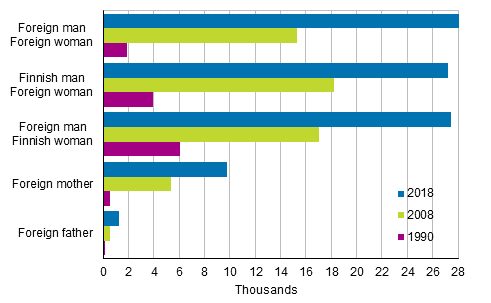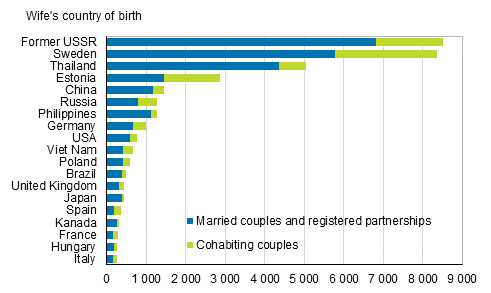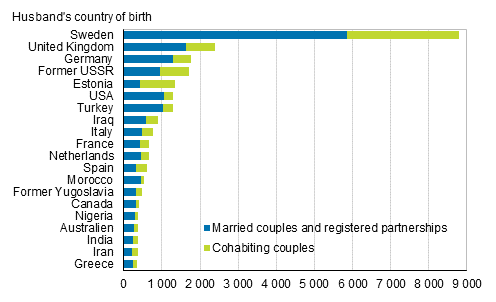2. Eighty-five per cent of families completely Finnish-speaking
In 85 per cent of all families, the only parent or both parents are Finnish-speaking. Correspondingly, four per cent of families are entirely Swedish-speaking. Families where one spouse is Swedish-speaking and the other Finnish-speaking account for three per cent of all families. Combinations of Finnish and Swedish-speakers with other languages can be found in around four per cent of all families. Families where both of the spouses or the only parent are foreign-language speakers number 70,990, which equals five per cent of all families. There is 756 families where at least one of the parents is Sami-speaking. The number of families that are purely Sami-speaking is 183.
In clearly more cases Swedish-speaking men have Finnish-speaking spouses than Swedish-speaking women Finnish-speaking spouses. The number of purely Swedish-speaking couples is only 3,461 higher than that of Finnish and Swedish-speaking couples. Altogether, 32,723 Finnish or Swedish-speaking men are married to or cohabiting with a foreign-language speaking woman. The corresponding figure for women is 26,341. Unions with foreign-language speakers increased by 2,000 in 2018.
Table 4. Families speaking Finnish, Swedish or other language in 1990, 2000, 2010, 2017 to 2018
| Man/woman Finnish, Swedish or other language speaking |
Year | ||||
| 1990 | 2000 | 2010 | 2017 | 2018 | |
| Finnish speaking man and Finnish speaking woman |
1 088 742 | 1 089 232 | 1 114 828 | 1 090 887 | 1 082 420 |
| Finnish speaking man and Swedish speaking woman |
16 544 | 17 394 | 18 337 | 18 358 | 18 327 |
| Finnish speaking woman and Swedish speaking man |
22 734 | 23 445 | 24 552 | 24 445 | 24 352 |
| Finnish speaking man and other language speaking woman |
4 020 | 11 094 | 21 772 | 29 649 | 30 595 |
| Finnish speaking woman and other language speaking man |
5 951 | 10 236 | 17 441 | 23 657 | 24 573 |
| Finnish speaking mother/father |
162 209 | 174 861 | 161 302 | 159 320 | 159 651 |
| Swedish speaking man and Swedish speaking woman |
53 348 | 49 198 | 47 881 | 46 391 | 46 140 |
| Swedish speaking man and other language speaking woman |
300 | 655 | 1 434 | 2 016 | 2 128 |
| Swedish speaking woman and other language speaking man |
410 | 678 | 1 261 | 1 720 | 1 768 |
| Swedish speaking mother/father |
8 489 | 8 609 | 7 953 | 7 834 | 7 737 |
| Other language speaking man and other language speaking woman |
1 832 | 11 668 | 27 638 | 49 279 | 52 198 |
| Other language speaking mother/father |
792 | 4 893 | 10 674 | 17 922 | 18 792 |
2.1 Russian speakers still the largest group among foreign-language speaking families
The largest foreign-language group in Finland is Russian speakers. At the end of 2018, there were 16,141 Russian-speaking families in Finland where the native language of the only parent or both parents was Russian. The number of families where either one of the spouses is Russian-speaking is slightly lower at 13,860. The number of Russian-speaking families is 726 higher than in the year before.
The number of Russian-speaking one-parent families is 4,574, which is 15 per cent of all Russian-speaking families. Among Russian-speakers, one-parent families are clearly more common than one-parent families are of all families (12.7%). Of Russian-speaking one-parent families, 94 per cent are formed by mothers and children, while this is so for 82 per cent of all families with one parent.
The most common language combination among the Russian-speaking families is one where the husband and the wife speak Russian. During 2018, the number of such couples has grown by 256. In 1990, there were only 300 Russian-speaking couples in Finland, today their number has gone up to 11,567.
The second most common language combination in Russian-speaking families is a Finnish-speaking husband and a Russian-speaking wife, 8,728. It is still rare for a Finnish-speaking woman to have a Russian-speaking spouse. At the end of 2018, the number of such couples was 1,797.
2.2 Families with Estonian citizens is the largest group of families with foreign citizens
In only six per cent (90,838 families) of all families in Finland at least one of the spouses or the only parent is a foreign citizen. There were only 12,500 such families in Finland in 1990 and as many as 36,000 in 2000. In the past year, the number of such families increased by 3,242.
In the early 1990s, the most common combination in families of foreign citizens was one where the wife was a Finnish citizen and the husband a foreign citizen. The number of foreign families in which the wife was a foreign national and the husband a Finnish national was the largest at the beginning of the 2000s. In 2013, the most common combination in families of foreign citizens was still one where the husband is a Finnish citizen and the wife a foreign citizen. In 2014, families of two foreign spouses became the most common family type for foreign citizens. Now the number of families formed by two foreign spouses is 28,419 (Figure 3). No distinction is made between married and cohabiting couples here.
In families where at least one of the spouses or the only parent is a foreign citizen, the largest group of foreign citizens is families with Estonian citizens, 15,173. In turn, families of Russian citizens number 11,650.
Entirely foreign families, i.e. families where the only parent or both spouses are foreign citizens, total 39,393. There were 4,727 families where both spouses or the only parent are Russian citizens at the end of 2018. There were 9,142 entirely Estonian families of which 32 per cent were families consisting of mother and children only. The number of Estonian families declined by 22 from the year before. Families of two Chinese citizens or with one Chinese parent numbered 1,491. The number of these families grew by 106 from the previous year. Thirteen per cent of the families of Chinese citizens are families of mother and children only.
Figure 3. Families of foreign citizens in 1990, 2008 and 2018

2.3 Men’s spouses more often born abroad than women’s spouses
An examination of countries of birth gives the best picture of foreign-born spouses of Finns. However, it should be borne in mind that some children of two Finnish citizens are also born abroad. For example, the child can be adopted, or the parents were living permanently abroad when the child was born.
Finnish-born men have 42,048 foreign-born spouses. The number has grown by 922 persons from the year before. Finnish-born women have 36,466 foreign-born spouses; the number having grown by 966 persons. So these days, Finnish men more often have spouses born abroad than Finnish women.
The foreign-born spouses of Finnish men and women come from a variety of countries. Men's spouses were born mainly in the neighbouring countries and East Asia. Those born in the area of the former Soviet Union cannot be separated into Russians or Estonians (or those born in other republics of the former Soviet Union), because even the Estonians' country of birth is mostly the Soviet Union and a large number of the spouses from Estonia had already moved to Finland before the collapse of the Soviet Union. Finnish men have 12,645 spouses who were born in the former Soviet Union, Russia or Estonia, and 8,362 spouses who were born in Sweden. The number of spouses born in Thailand is 5,044. The next most common countries of birth for the spouses are China, the Philippines, Germany, the United States and Vietnam.
Women's spouses born abroad come from a larger variety of countries than men's spouses. The number of spouses born in Sweden is 8,790. Husbands born in the former Soviet Union, Russia and Estonia number 3,404. The next most frequent countries of birth of Finnish women's foreign spouses are Great Britain, Germany, the USA and Turkey.
Figure 4A. Foreign-born spouses of Finnish-born men by country of birth in 2018

Figure 4B. Foreign-born spouses of Finnish-born women by country of birth in 2018

Source: Population and Justice Statistics, Statistics Finland
Inquiries: Marjut Pietilšinen 029 551 2798, Joonas Toivola 029 551 3355, Timo Nikander 029 551 3250, info@stat.fi
Director in charge: Jari Tarkoma
Updated 31.01.2020
Official Statistics of Finland (OSF):
Families [e-publication].
ISSN=1798-3231. annual review 2018,
2. Eighty-five per cent of families completely Finnish-speaking
. Helsinki: Statistics Finland [referred: 19.4.2025].
Access method: http://stat.fi/til/perh/2018/02/perh_2018_02_2020-01-31_kat_002_en.html

